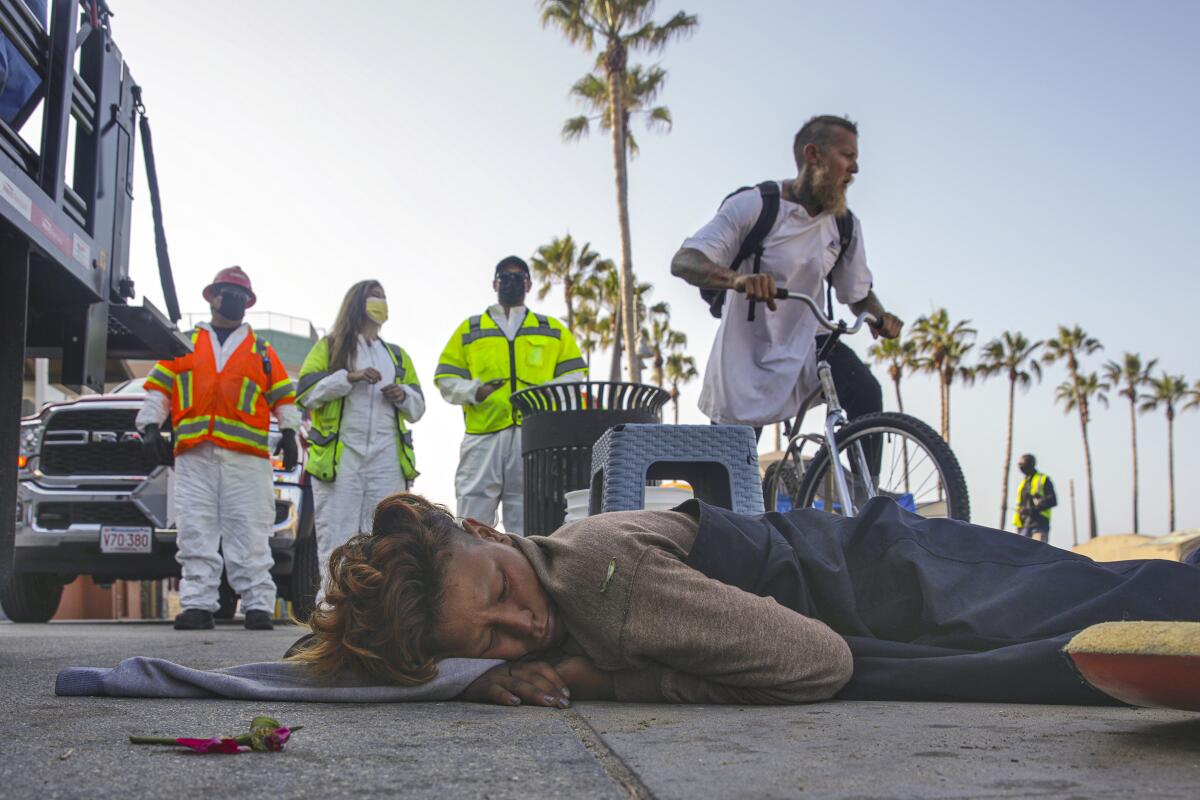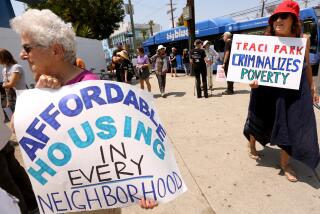Column: Is homelessness a property rights issue or a human rights issue? We have to decide

- Share via
Everyone in Los Angeles seems to agree that homelessness is an emergency, and that consensus has existed for years.
In 2016, voters overwhelmingly approved Proposition HHH and allocated $1.2 billion to homeless housing and programs. A Times poll in 2019 showed that 95% of voters called homelessness a serious or very serious problem. And homelessness figures to be the main issue of next year’s mayoral race.
But I think there’s a major disagreement about what kind of problem homelessness actually is.
For one group, the crisis is about the unchallenged misuse of public and private property. It’s a problem of wounded civic pride, lowered property values and dwindling tourism and investment dollars, with a seemingly easy solution: Just get homeless people out of our parks and off our sidewalks.
For the other side, the crisis is one of people lacking homes and the maelstrom of medical, psychological and addiction problems that accompany a life on the streets. To them, the main problem is a rapacious, profit-maximized real estate market that generates evictions and homelessness faster than we can house homeless people. And a perfect solution to this problem doesn’t quite exist.
We saw this dichotomy play out on Venice boardwalk these last few weeks. With a backdrop of tents and homeless people, Council member Joe Buscaino launched his mayoral campaign with a speech lamenting the inhumanity of tent life and promising to more forcefully remove tent dwellers from public spaces. After the cameras and politicians left, aid workers and staffers organized by Council member Mike Bonin slowly wound their way down the boardwalk, trying to connect homeless people to services and housing.
With elections approaching, we have to ask ourselves what kind of issue we believe homelessness to be. There are at least 60,000 homeless people in Los Angeles, and according to a recent analysis, up to 365,000 renting households are at risk of eviction.
The easy answer is to say that homelessness is both a property rights and human rights issue. But the truth is, enforcing property rights on homeless people only makes it harder to treat them. And treating homeless people likely requires us to make ending homelessness a higher priority than our home values or our enjoyment of parks, beaches and sidewalks.
The history of homelessness testifies to the futility of trying to find solutions that average these two perspectives, said Marques Vestal, an assistant professor of urban planning at UCLA who helped author last year’s Luskin report on the history of homelessness. (Full disclosure: Vestal is my friend and was my roommate at UCLA.)
When thousands of unemployed white men began to settle around a Southern Pacific Railroad passenger terminal in the late-19th and 20th centuries — the area now called skid row — they tried to build their own housing on undeveloped lands. City officials designated these structures and people as a serious threat to public welfare, destroyed their temporary homes and sent them to jail. The resultant overcrowding led to a major expansion of the region’s jail system.
During the Great Depression, facing an exploding homeless population that included many migrants from other states, city leaders established a work test and ID card system that would allow homeless people the right to food and shelter for three days. When your three days were up, the police would check your ID card and force you to leave the city.
Homeless people built shantytowns called Hoovervilles on unused land, the name intended to mock then-President Hoover’s handling of the economic crisis. When the U.S. entered World War II, the shantytowns were destroyed, and the city’s homeless multiplied.
In the 1980s, Los Angeles lost thousands of manufacturing jobs. Declining tax revenues led to cuts in social services and massive cuts in mental health services. Across America, the practice of buying and selling real estate as an investment asset incentivized a new approach to property, with developers and city leaders pushing for the maximization of the rate of return on every parcel of land.
The passage of the Ellis Act in 1986 granted landlords more eviction power. Thousands of people, largely Black and Latino people, became homeless. City leaders returned to a familiar playbook: Police enforced property rights and arrested more mentally ill and homeless people, turning the Los Angeles County jail into the largest mental health facility in the nation.
Over and over, the pendulum of public opinion swings between enforcement and aid; between property rights and human rights; between homelessness as individual pathology and failure, or homelessness as a condition of rapacious housing markets.
But only one perspective offers even the possibility of a long-term solution.
We have to value human rights over property rights. We have to start seeing that homelessness is a natural result in a country where residential property is traded like an asset on Wall Street. We need to understand that when a city’s housing stock is monopolized by private capital from around the world seeking higher returns, affordable housing will always be replaced by expensive housing. As long as we don’t have enough affordable housing, we will always have homelessness in Los Angeles.
“You can’t just criminalize a condition that people can’t cure,” Vestal said. “These problems that we have created — they are all intimately tied up with the good things we thought we were making of our society.”
What solutions we choose for homelessness are deeply entwined with what stories we tell about homelessness. What bothers me is that we are still demanding that homeless people prove they deserve our help. We imagine that we can evaluate all of a homeless person’s decisions and judge their worth and morality. We can easily generate sympathy for a homeless person as long as their response to homelessness has neatly avoided those behaviors that we deem immoral — drug use, crime or violence.
But just think of yourself at the worst, lowest point in your life. Would you be able to survive the scrutiny that homeless people must endure to receive our aid?
Over this last year, as I’ve struggled with severe depression, I’ve had occasion to imagine my own slide into homelessness. More than two-thirds of homeless people in Los Angeles are experiencing it for the first time, according to a 2020 survey.
Maybe my mental health would decline precipitously. I would alienate friends and loved ones. Maybe then I would lose my job, or experience an unexpected financial setback, such as having to care for relatives or pay for a car accident or parking ticket. According to the survey, 59% of people experiencing homelessness for the first time cite economic hardship as a reason, and 2 in 3 homeless people are mentally ill.
Without my job, I might lose my housing. If I could overcome the shame and stigma of being houseless, I would tap my social network and ask friends and family for help. Then, at some point, maybe their help would run out, and then I’d have no place to live.
Perhaps while I figured out a plan, I would sleep in my car. Then I’d risk getting my car impounded if I parked in the wrong place. I wouldn’t be able to afford the fee to get it back, drastically limiting my employment options. Maybe then I’d sleep on a park or on a sidewalk, and be arrested for sleeping outside. Without easy access to showers, bathrooms and laundry, I would no longer be welcome in public spaces.
Lacking any other way to ease my suffering, maybe I would partake in the ubiquitous, predatory drug trade on skid row, and add addictions to my problems. Maybe I’d try to live near the beach. I’d avoid shelters because even homeless people fear being around the severely mentally ill. I would spend all my energy trying and failing to feel safe.
After experiencing all of this, I doubt that I would be regarded as a sympathetic character. And, I suspect, neither would any of you.
More to Read
Sign up for Essential California
The most important California stories and recommendations in your inbox every morning.
You may occasionally receive promotional content from the Los Angeles Times.











